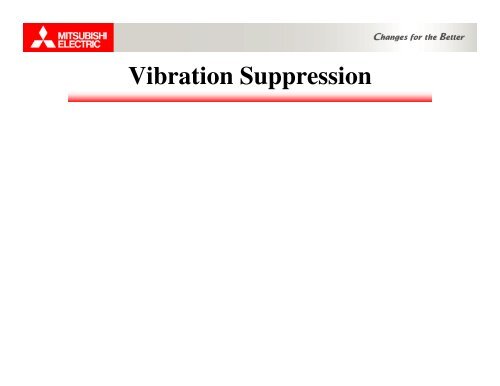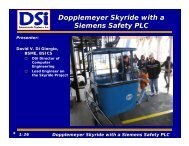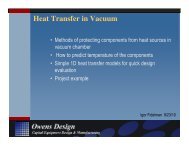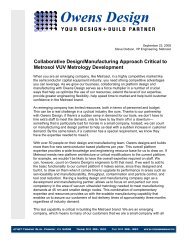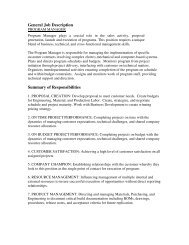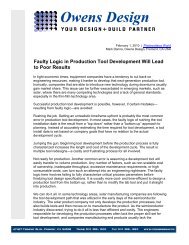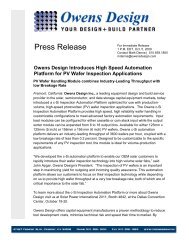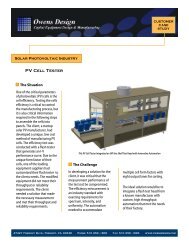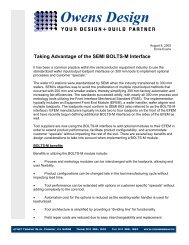Vibration Suppression - Owens Design
Vibration Suppression - Owens Design
Vibration Suppression - Owens Design
Create successful ePaper yourself
Turn your PDF publications into a flip-book with our unique Google optimized e-Paper software.
<strong>Vibration</strong> <strong>Suppression</strong>
Summary<br />
What is vibration<br />
What causes vibration<br />
Why is it important<br />
How to control vibration<br />
Damping<br />
Motion profile<br />
Technology behind vibration suppression<br />
Encoder<br />
<strong>Vibration</strong> detection<br />
How to implement vibration suppression<br />
Added control output<br />
Applications
What is <strong>Vibration</strong>?<br />
<strong>Vibration</strong> refers to mechanical oscillations about an equilibrium point.<br />
The oscillations may be periodic such as the motion of a pendulum or<br />
random such as the movement of a tire on a gravel road.<br />
<strong>Vibration</strong> is occasionally desirable. For example the motion of a tuning<br />
fork, the reed in a woodwind instrument or harmonica , or the cone of<br />
a loudspeaker is desirable vibration, necessary for the correct<br />
functioning of the various devices.<br />
More often, vibration is undesirable, wasting energy and creating<br />
unwanted sound--noise. For example, the motions of engines, electric<br />
motors, or any mechanical device in operation are usually unwanted<br />
vibrations. Such vibrations can be caused by imbalances in the rotating<br />
parts, uneven friction, the meshing of gear teeth, parts that are<br />
dragging together, etc. Careful designs usually minimize unwanted<br />
vibrations.
What is <strong>Vibration</strong>?<br />
What causes vibration?<br />
Forces generated within the machine cause vibration. These forces<br />
may be ones that:<br />
Change in direction with time, such as forces generated by rotating unbalance.<br />
Change in amplitude or intensity with time, such as forces generated in an<br />
induction motor due to unequal air gap between the motor armature and stator<br />
(field).<br />
Friction between rotating and stationary machine components in much the same<br />
way that friction from a rosined bow causes a violin string to vibrate.<br />
Cause impacts, such as impacts generated by the rolling elements of a bearing<br />
passing over flaws in the bearing raceway.<br />
Cause randomly generated forces such as flow turbulence in fluid-handling devices<br />
such as fans, blowers and pumps; or combustion turbulence in gas turbines or<br />
boilers.
How to control vibration?<br />
Damping
Technology behind vibration suppression<br />
Encoder
Encoder Technology<br />
LED<br />
LED<br />
Encoder<br />
Disc<br />
Photo<br />
Sensor<br />
Squaring<br />
Circuitry<br />
LED<br />
Motorshaft<br />
Sensors
Ultra Compact Size:<br />
Encoder Technology<br />
High density coil using new joint-wrap core method<br />
Circular core + mass winding<br />
<br />
Flat core + mass<br />
winding<br />
New, small size encoder development<br />
Joint-wrap core + Flyer mass winding<br />
Prism<br />
1000 p/r 130k p/r<br />
260k p/r<br />
Glass disc<br />
Permeate optical+Increment<br />
Glass disc<br />
(ABS code)<br />
ABS+High resolution(self-development)
・Suppress the mechanical vibration by auto-tuning<br />
Motor position<br />
-1000<br />
速 度 1000 指 令 [rad/s] 位 置 ドループ[um] INP(±10um) -500<br />
速 度 指 令 [rad/s] time[sec] 50000.511.522.533.544.55<br />
-1000<br />
速 度 1000 指 令 [rad/s] 位 置 ドループ[um] INP(±10um) -500<br />
速 度 指 令 [rad/s] time[sec] 50000.511.522.533.544.55<br />
In-Position signal<br />
Machine position<br />
荷 側 ドループ[um]<br />
Tuning on<br />
負<br />
-1000 負 荷 側 ドループ[um]<br />
Machine will vibrate with<br />
high gain setting<br />
time[sec] -50000.511.522.533.544.55<br />
Eliminate vibration High Response<br />
-1000 -500 time[sec] 00.511.522.533.544.55
How to implement vibration suppression<br />
Control output
-1000<br />
2000<br />
速 度 [r/min] Experimental Result of J3 Auto-Notch, FixedplntAatu12SmallAdapting.mat, 20-May-2003<br />
wmref<br />
-2000<br />
Adaptive Filter Ⅱ<br />
・Suppress the vibration at high gain setting<br />
★ Frequency range increases : ~4.5KHz<br />
0.5 1.5 2.5 3 3.5 時 間 [sec] 0 1 2<br />
1.5 2 2.5 3 3.5 -200 -100<br />
200<br />
トルク [%] Tsample=0.002[sec], Ttotal=4[sec]<br />
時 間 [sec] 1 0.5 0<br />
Auto-Tuning ON
Advanced <strong>Vibration</strong> Control<br />
Model droop pulses<br />
-<br />
Motor droop pulses<br />
+<br />
Searching Freq<br />
part<br />
Filter<br />
The filter which is installed in front of the<br />
loop control part is tuned by this function<br />
Control<br />
part<br />
Command<br />
pulses<br />
Filter<br />
PG1/PG2<br />
/VG/VIC<br />
Loop control<br />
Current<br />
control<br />
Motor<br />
ENC
Advanced <strong>Vibration</strong> Control<br />
Droop pulses ≦δ<br />
ON<br />
<strong>Vibration</strong> level
Advanced <strong>Vibration</strong> Control


